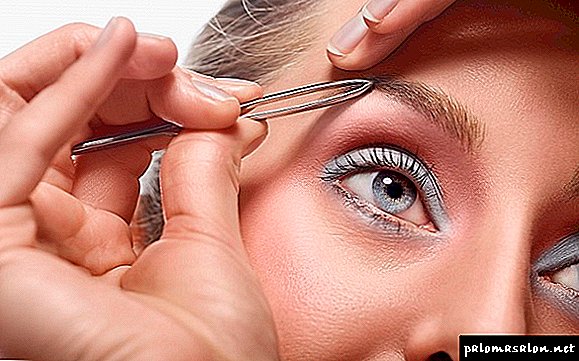No Chemotherapy aims to prevent cell division. Hair grows constantly, the cells of the hair follicle very quickly divide. Cytostatics stop the growth of tumor cells along with the growth of hair follicle cells.
Hair loss is a problem number one, after chemotherapy, but it is not scary and not dangerous, after the chemotherapy is no longer effective and the hair is removed from the body, hair growth will resume again. Hair loss is due to the fact that during chemotherapy cell division decreases, and hair cells more quickly divide than some cells of the body.
Some other drugs, such as methotrexate or the Russian version of Vero-Methotrexate, can affect hair loss.
The main thing is that chemotherapy helps people, and hair is secondary.
To avoid hair loss during chemotherapy is usually not possible. It occurs from a strong toxic effect of drugs. Who this happens after the first series of injections, and someone later. Depends on youth and strength of the body. But you should not despair. After completing the course of chemistry, hair is able to recover and grow. And to help the body, restoring diets and vitamin therapy are needed. Of course, you want to look good and feel confident, but isn't life more precious than these temporary difficulties? Love yourself and stay healthy!
I have a friend. She is a librarian. Eight years ago, during a gynecological examination, she was diagnosed with cancer. Have had an operation. She passed chemistry.
She went to work - and everyone quietly wondered why her hair was there.
She is convinced that the reason is that she drank sour natural juices every day and ate fatty fish. No one has confirmed this, but she still drinks orange juice every day without sugar, fries carp for herself, or makes crucian carp in sour cream and enjoys life.
Almost impossible, the only thing that hair loss depends on the dose of chemotherapy, which is calculated on the patient's body weight. Chemistry causes a strong poisoning of the body, because of this, the hair falls out; Usually, after the first course, about the 25th day, hair loss begins. But many people have different ways, someone becomes completely bald for the whole course of chemistry, my hair remained only slightly less often than usual, and some had good thick hair, but short, by the fourth course. As soon as you see that the hair began to fall out, do not feel sorry for them, immediately cut your hair under the machine, you can leave it 1 cm long, and then when it’s completely bald, it is very hot to sleep, without hair the head sweats a lot, there is no layer. Therefore, I had to sleep at first in a headscarf. It is better to collect short hairs by bed than long ones everywhere, and doctors swear at procedures. Hold on! The main thing is health, and then the hair will grow even thicker and become curly.
Does hair always fall out
Will the hair hurt or not, depends on the chemicals used. They are divided into several groups, which are classified by different colors and intensity of action.
- Red chemotherapy the strongest. It belongs to the antacycline group drugs. After treatment, all curls fall out almost immediately.
- Yellow - more gentle. Curls fall out, but it happens after a while.
Most of the recent chemotherapy drugs do not cause severe side effects. Hair, though, and fall out, but only partially, which is imperceptible to others.
In radiation therapy, hair loss occurs when the hairy area of the head is the site of exposure. Irradiation of other parts of the body does not cause alopecia. Alopecia is also absent with hormone therapy.
How fast fall out and when they start to grow again
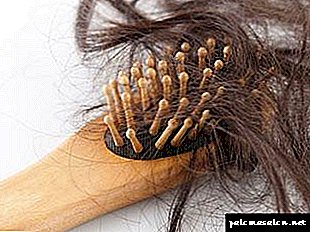 No doctor can accurately determine on what day after the course of chemotherapy alopecia will occur. The human body is individual, each endures side effects in different ways.
No doctor can accurately determine on what day after the course of chemotherapy alopecia will occur. The human body is individual, each endures side effects in different ways.
From one chemical substance in some patients, hair loss occurs immediately, while others - this phenomenon is observed after a few weeks.
Alopecia during chemotherapy is inevitable. This is the body's natural reaction to the introduced chemical.
This fact adversely affects the psyche of a woman. Men treat this phenomenon more calmly. It happens that women refuse chemotherapy to maintain their hair.
Do not worry because of temporary alopecia, after completing courses of chemotherapy, curls grow back again. Active growth is observed three months after the completion of treatment.
Where do hair fall out
Chemotherapy has a side effect from all parts of the body. The scalp suffers more, full baldness can be observed there. The coat on the pubis and perineum, legs, arms, and underarm area are mostly preserved. There may be a decrease in hair in these areas. It all depends on the duration of the course of treatment.
Eyebrows and eyelashes are also saved. But, as mentioned above, it all depends on the body. And each person transfers this state in his own way.
Is it possible to prevent
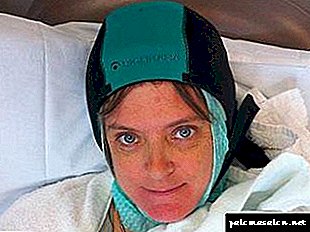 It was possible to avoid hair loss using the cooling method. Exposure to cold helps to reduce blood flow to the scalp. Subsequently, the hair follicles are less susceptible to the action of chemicals. This method allows to reduce or prevent the loss of curls.
It was possible to avoid hair loss using the cooling method. Exposure to cold helps to reduce blood flow to the scalp. Subsequently, the hair follicles are less susceptible to the action of chemicals. This method allows to reduce or prevent the loss of curls.
The doctor before chemotherapy for 15 minutes puts on the patient's head a helmet in which there is a cooling gel. By reducing the temperature in the scalp, blood supply to the follicles is reduced.
The hair begins to absorb less toxic substances. After completing the course of chemistry, the helmet should remain on the head for at least another 30 minutes. This method is effective in 50–70% of cases.
To prevent hair loss, you can resort to the drug Minixidil. Early it was used as a hypertensive agent. To save curls, the drug must be rubbed into the scalp. It removes loss, and at the end of treatment accelerates growth. But Minixidil has side effects and contraindications that need to be read in advance.
To reduce the loss will help proper care at home:
- Protect curls from the negative impact of the environment. It is recommended to wear hats in hot summer days and in the cold season.
- Before the course of chemotherapy, you can not wash your hair before the procedure and after - during the week. The less curls undergo any treatments during treatment, the more they will remain.
- You can not comb your head for 10-12 hours after chemistry. At this time, the scalp is most sensitive.
- Shampoo should be used "soft". Water should be barely warm. After washing, the towel should be applied to the hair with care.
- Hair styling using heat treatment is not recommended.
- From painting and the use of varnishes, gels for fixing curls should be abandoned.
 With the help of folk remedies can prevent or delay the onset of alopecia. Traditional medicine offers a wide selection of recipes for washing and rinsing curls with decoctions of various herbs.
With the help of folk remedies can prevent or delay the onset of alopecia. Traditional medicine offers a wide selection of recipes for washing and rinsing curls with decoctions of various herbs.
Oils for rubbing into the skin of the head with healing properties like: burdock, linseed, castor. Broths from burdock root, malt and hops, nettle - also have a beneficial effect on strengthening the roots of curls.
The use of egg yolk with soda in equal proportions also prevents hair loss. To do this, apply the mixture to the hair roots and leave for 10 minutes. After that, the mask should be washed off with slightly warm water. The yolk is rich in trace elements. During the application of the mask hair absorbs the richest composition of the elements.
An important point! Before using any means, you must first consult with an oncologist. Without permission to do something and take any drugs is prohibited.
Masking methods
Hair loss in a woman is a blow and psychological trauma. But to refuse treatment in order to preserve the beauty of curls is tantamount to suicide.
Temporary baldness can be hidden in many ways. For example, using:
When choosing a wig is better to give preference to natural hair. This wig will look more natural, which will protect from unnecessary questions and views from others. Who does not want to wear false hair, can hide his bald head with the help of headgear. Perfectly selected make-up gives women confidence and beauty.
Health is paramount. You can not refuse chemotherapy, so as not to lose their luxurious curls. When a terrible diagnosis is made - cancer, you need to fight for your life and believe in a happy outcome of the disease. Medicine is so developed that it has found a way to cure many oncological forms.
Useful videos
How to keep beauty and density of hair after chemotherapy.
How to preserve the beauty of the hairstyle after chemotherapy, hair care, shaving or not shaving, and many other secrets from personal experience will be revealed by Irina Ruta.
Chemotherapy and hair loss are important details.
You should not think that if a patient is prescribed chemotherapy, then he will definitely lose hair completely. There are drugs, the use of which simply makes the hair noticeably less often, and some of them even affect the cancer cells to a point, without destroying the hair follicles.
The condition of curls after treatment and the rate of their regrowth are influenced by the following factors:
the number of chemotherapy courses - the more they are prescribed, the higher the chances of complete hair loss,
the age of the patient - the elderly are more at risk than patients under 40 years of age,
the dosage of the drugs and the individual reaction to them - large doses, of course, pose a more serious danger, but at the same time the reaction to the same dosage is different for different people,
degree of aggressiveness of drugs,
Features of the structure and condition of the hair before the start of chemotherapy.
Many are interested in when hair loss begins after chemotherapy. As a rule, side effects in the treatment of malignant tumors declare themselves a few weeks after the start of the first course of treatment. First, the patient experiences painful and itchy scalp, and then hair begins to fall out. The process can go on sharply or gradually and affect the hair not only on the head, but also on the body.
How to stop hair loss with chemotherapy
Experts advise to prepare for possible changes in appearance in advance: even before the start of treatment, make a short haircut and refuse hair coloring and perm. After these procedures, the hair during the administration of chemotherapy drugs will fall out stronger.
In order to minimize the effects of taking medications, you must still follow the recommendations during treatment:
for combing it is better to use brushes and combs with a soft bristle - this will protect the already fragile hair structure from damage,
will help to save from the rapid loss of hair constant use of the house rubber cap,
wash your hair as rarely as possible and only with warm water, and after washing you should not twist it, it is better to just blot with a towel and let it dry naturally without a hairdryer,
for washing and hair care is better to use soft products based on vegetable raw materials,
at least once a week to make masks from oils (burdock, flax, castor),
do not leave the house without a headdress, protecting the head from the harmful effects of the external environment.
All this will help to stop hair loss after chemotherapy and to achieve the earliest possible restoration of their original appearance.
And do not forget that recovery is a long process that will take at least 6 weeks. Be prepared for the fact that after chemotherapy, the hair can change its structure, becoming more wavy or, conversely, significantly losing curliness.
Chemotherapy hair loss is an effective way to heal and mask
Long-term recovery entails a number of psychological problems. Do not give in to depressed mood! The situation can be saved by high-quality wigs made from natural hair, as well as decorative bands and scarves, intricately tied around the head.
To restore hair, you can use special tools. The ALERANA ® series has a healing effect on the hair follicles and helps in the process of hair restoration.
The last and most valuable advice: faced with cancer, use all your strength to fight the disease, sacrificing, if necessary, and beauty. Remember, hair will grow back and look to the future with hope and optimism.
Effect of chemical therapy on hair
Does hair fall out after chemotherapy? One of the most common side effects of chemotherapy is hair loss.
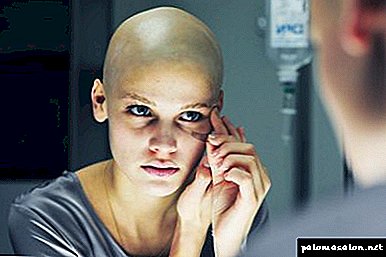
This fact often scares many people, especially women. Some of them can not even decide on such treatment because of the fear of losing hair.
But the desire to keep your hair should not interfere with vital procedures. And besides, not all chemotherapy robs a person’s hair.
To get started is to understand why it is such a side effect. It's all about drugsused during chemical procedures, the so-called cytostatics.
These anticancer drugs block cell division, and in the very first turn their attention to the most active of them.
Such alopecia can spread to the whole body, including eyebrows and eyelashes.. At this time, the psychological state of the patient becomes very important. Indeed, temporary baldness is added to the already existing serious illness, which can lead to the appearance of large episodes of stress.
After what chemotherapy does hair fall out? Does hair always fall out during chemotherapy? Not all cytotoxic drugs promote hair loss.. A small number of them can only cause partial baldness, or even not cause it at all.
For example, in the treatment of breast cancer Cyclophosphamide and Methotrexate follicle hair cells are not affected at all. The number of such drugs is small, but they are.
When does hair loss begin after chemotherapy? As for the timing of the start of hair loss, it can vary depending on the type of drug and the human body. Usually, the hair becomes thinner after the first chemotherapy session, and the gradual loss of hair starts 1 to 2 weeks after the start of treatment.
In addition, there is method that protects hair from the harmful effects of cytostatics. This procedure is called cooling the hair follicles (or cooling the scalp).
Its essence is that immediately after chemotherapy, a special apparatus is put on the patient's head, which cools the scalp, thereby reducing the diameter of the arterial vessels. This leads to slower blood flow and lymph flow, and therefore prevents the delivery of chemicals to the hair follicles.
Naturally, this procedure does not completely stop blood circulation, so there can be no complete prevention of baldness.
The doctor will tell you why hair falls out after chemotherapy:
After chemotherapy, hair falls out: what to do?
Often the balding process accompanied by irritation and drying of the skin, redness of the hair areas head, etc. However, this process can be facilitated.
To eliminate unwanted complications you just need to be careful with your hair and follow some rules:

- Do not immediately run home after chemotherapy rush to wash your hair. You need to wait at least a few days, letting your hair rest after the treatment,
- wash only with warm, but by no means hot water. High temperatures can cause even more dry skin and hair,
- the same goes for hair dryers. At the time of chemotherapy, it should be abandoned or use the mode with the lowest temperature of incoming air,
- Do not use hard combs, curlers, curling procedures and hair straightening. This will lead to even greater loss.
- use only mild moisturizing shampoos. They will help keep your skin healthy,
- Some cosmetics may be contraindicated during chemical procedures, so discuss this point in advance with your doctor.
In general, during this period It is recommended to disturb your hair as little as possible.. They are very fragile and depleted, so even standard combing can have a negative effect.
Terms and methods of recovery
To grow back the hair, as a rule, begins several months after the completion of chemotherapy. Immediately it is worth preparing for the fact that this process is long, so that Their full recovery can be expected only after 5 - 6 months.
What is interesting in the recovery process hair locks acquire a different structure. They may become stiffer or curly, but when they are fully restored, they will acquire their natural structure.
Many cancer patients after treatment can not accept this situation, and especially women. And wigs and headdresses are not limited to one thing. In an effort to return the lost hair as soon as possible. resort to a variety of methods, but not all of them are effective.
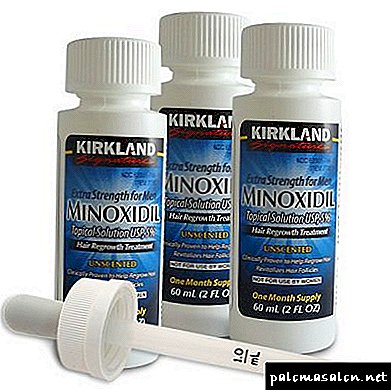
A variety of moisturizers, serums, lotions, oils and balms are recommended.
For example those that contain Minoxidil. They not only moisturize the skin and restore the metabolism, eliminating the unpleasant itching, but also stimulate the growth of new hair, have proven themselves and repair masks.
Recipes using olive oil, onion, mustard and pepper warm up the skin well, making it better to bleed the blood, so needed follicles for the speedy recovery,
It can be used to solve cosmetic problems (brittleness, paleness of hair) with the help of natural active substances, and to combat alopecia using complex chemical mixtures. The only thing that you can resort to it only after the completion of oncological treatment.
Baldness threatens a person or not, you should not get upset about it. Good psychological state - the first step towards healing. After all, half a year without hair is not such a long time; besides, it can be significantly reduced in various ways. And if you are lucky with drugs, then avoid it altogether.
Why does hair fall out during chemotherapy?
Chemotherapy drugs are substances that are cytostatics (slowing down or stopping cell division). In the first place cytostatics affect the most actively dividing cells. In addition to the tumor cells themselves, the hair follicle cells are also capable of active division. Therefore, cytostatic drugs affect them, stopping their division, which ultimately leads to alopecia.
Does hair chemotherapy always fall out?
Not always. For example, in the treatment of breast cancer if a treatment regimen using cyclophosphane, methotrexate and 5-fluorouracil is used, the hair may not fall out completely. Modern chemotherapy regimens have significantly reduced the likelihood of hair loss. In almost half of all cases of chemotherapy, alopecia is not observed.
The likelihood of alopecia can be assessed using the following criteria:
- used chemotherapeutic drugs and their dosage,
- number of chemotherapy courses,
- age of the patient
- patient's hair type.
When do hair begin to fall out?
Often, before hair loss, scalp irritation occurs. As a rule, hair begins to fall out after 2-3 weeks after starting a course of chemotherapy. In some cases, this happens earlier, and sometimes later. It all depends on the physiological characteristics of the patient and the treatment prescribed.
When does hair start to grow?
No matter how terrible (from a psychological point of view) the patient’s loss hair, need to remember. That alopecia is always temporary, and after a certain amount of time the scalp is restored. Usually, the first hair begins to grow by the end of the chemotherapy course. At first, the most “enduring” (strong) hairs appear, so the initial hairline may be stiff. Full restoration of the usual hairstyle occurs approximately 3-6 months after the end of chemotherapy.
Patient tips
If you have to undergo a course of chemotherapy, then to save your hair, you need to use the following recommendations:
- be sure to discuss with your doctor the possible risks of hair loss, depending on the proposed treatment regimens,
- Avoid combing and washing your hair immediately after a chemotherapy session. It is best to wait 5-7 days, and only then wash your hair with warm water using a mild shampoo,
- Do not use a hair dryer to dry hair. This is best done by gently putting a towel on the head,
- protect your hair from direct sunlight
- during sleep, use a soft and gentle pillow.
What chemotherapy does hair fall out with?
According to medical specialists in the field of oncology, not all of the drugs used in chemotherapy have the detrimental effect on the hair, which leads to their loss. To understand what causes hair loss, consider what chemotherapy hair falls out?
- Drugs aimed at actively counteracting the progress of tumor neoplasms can cause either complete or partial hair loss.
- The drug Cytoxan or cyclophosphamide used during chemotherapeutic courses in the treatment of breast cancer leads to the fact that the hair becomes thinner and alopecia occurs.
- The consequences of the use of the drug Adriamycin (doxorubicin), indicated for the treatment of breast cancer and many internal organs, during the first 3 weeks of the course are manifested in thinning hair, and subsequently - in their complete loss.
- Due to chemotherapy with pakletaxeol, also known as Taxol, hair can fall out suddenly and all at once. That is, it is likely that one morning to wake up and find yourself completely bald.
However, the current level of development of drug-based chemical agents suggests the presence of drugs that have a strictly targeted effect on the cells affected by pathological processes. Using them during chemotherapy almost completely eliminates the problem of hair loss from the list of side effects associated with such treatment.
If you want to improve the condition of your hair, special attention should be paid to shampoos that you use. A frightening figure - in 97% of shampoos of famous brands are substances that poison our body. The main components, due to which all the troubles, on the labels are designated as sodium lauryl sulfate, sodium laureth sulfate, coco sulfate. These chemicals destroy the structure of the hair, the hair becomes brittle, lose elasticity and strength, the color fades. But the worst thing is that this filth enters the liver, heart, lungs, accumulates in the organs and can cause cancer. We advise against using the means in which these substances are located. Recently, experts of our editorial staff conducted an analysis of sulfate-free shampoos, where the first place was taken by funds from the company Mulsan Cosmetic. The only manufacturer of all-natural cosmetics. All products are manufactured under strict quality control and certification systems. We recommend to visit the official online store mulsan.ru. If you doubt the naturalness of your cosmetics, check the expiration date, it should not exceed one year of storage.
In order to understand at what chemotherapy the hair falls out, it is necessary first of all to understand the mechanisms of action of chemotherapy drugs. These are predominantly active substances with cytostatic properties, which means their ability to slow down or stop the process of cell division.
Their action is directed to cells in a state of active division and reproduction. Since cells of the hair follicle have such properties, they also undergo the effect of stopping cell division produced by chemical preparations. As a result, alopecia appears.
To assess the likelihood of hair loss during chemotherapy, such criteria as the patient's age, dosage and specific features of the drugs used, the number of prescribed therapeutic courses, as well as the patient's hair type are relevant.
When hair starts to grow
No matter how terrible (from a psychological point of view) the patient’s loss hair, need to remember. That alopecia is always temporary, and after a certain amount of time the scalp is restored. Usually, the first hair begins to grow by the end of the chemotherapy course. At first, the most “enduring” (strong) hairs appear, so the initial hairline may be stiff. Full restoration of the usual hairstyle occurs approximately 3-6 months after the end of chemotherapy.
Hair care during chemotherapy
Hair care during the period of illness is simple:
- When combing the hair is not recommended to use irons, curling, hair dryer, in a word those styling items that heat the hair.
- Use a comb or a soft-haired brush to avoid damaging already fragile hair.
- It is necessary to wash hair only if necessary and at the same time to use very soft shampoo.
- When undergoing chemotherapy, do not resort to chemical perm and hair coloring.
- They make hair brittle, lifeless and weak. And it depresses hair even more.
- Wear headgear on your head, which will protect your head from overheating in summer.
- It would be very nice to use such an accessory as a scarf - very fashionable and stylish, besides, there are a lot of options for tying a scarf.
Hair restoration
- Scalp recovery after chemotherapy usually begins 6 weeks after the end of chemotherapy and requires long-term care.
- As well as during chemotherapy, refuse to use hot hair styling, their coloring and all procedures that may harm the hair.
- Before washing the head, massage the scalp while adding olive, nettle or burdock oil.
- After this, make a greenhouse for hair, winding hair with cellophane or wearing a rubber hat and wrapping it all with a towel.
- After two hours, remove and wash the hair with a shampoo with the addition of essential oils. Wash your hair with warm water only (not hot!).
- Shampoo is desirable to use children. In extreme cases, one that does not contain sodium lauryl sulfate.
- Be sure to use hair nourishing masks and rinses based on vegetable raw materials.
- Do not twist hair when wiping, and just soak a towel.
- Conduct a constant massage of the head, starting to massage the skin in the direction from the forehead to the temples and the back of the head. At the same time, finger pressure on the skin should be strong in order to achieve blood flow to the hair follicles.
- Drink decoctions of flaxseed, rosehip, oats, barley.
Hair coloring after chemotherapy
Very relevant for women undergoing treatment with the use of chemicals, accompanied by such a side effect as hair loss is the problem of their recovery. One of the factors of female beauty and attractiveness is hair color and the possibility of their coloring.
Hair coloring after chemotherapy can be started after six months from the end of the last course of treatment. It is not recommended to expose the hair to such an effect earlier because the dyeing as well as the perm may weaken the immune system and increase the hair's vulnerability to adverse environmental factors. As a consequence, it is even possible to increase the intensity of prolapse, which can trigger the appearance of focal alopecia.
In the event that chemotherapy was preceded by staining or permed by chemical means, the structure of the hair becomes thinner and brittle.
Dyeing hair after chemotherapy requires close attention in choosing the appropriate dye for use. The best option is a paint that does not contain carcinogens, if possible - in the production of which only components of natural origin were used.
Ways to accelerate hair growth after a course of treatment
During chemotherapy, you can hide baldness with wigs or hats. Psychologists note that in such a period moral support is very important for the patient. The patient should understand that hair loss is almost inevitable, and stop worrying about it. It is important to remember that extra stress is undesirable for you.
Rapid hair growth is observed in patients adhering to proper nutrition and not experiencing stress. Some time before the start of treatment, patients should stop dyeing their hair, and use straighteners. This will give your curls strength and delay baldness.
Vitamins have an important role during recovery, but before starting any medications you need to consult your doctor. Vitamins of group A, C and E, important for the patient during the recovery period, are vitamins of group B, because its representatives B1, B2 and B6 vitamins promote the development of cancer cells.
During recovery, the patient should monitor the level of hemoglobin, because its reduction contributes to hair loss. To do this, you need to eat more vegetables and fruits, but do not forget to coordinate everything with your oncologist.
Accelerated hair restoration after alopecia will contribute to the following methods.
Protein Masks
This method helps in strengthening and restoring the hair structure. Such masks can be easily prepared on their own, but it is important to consider that professional tools can contain components that prevent over drying of the scalp and hair. This type of masks will also help improve the structure of new hair, prevent their fragility and give them strength.
Adaptogens
After a course of chemotherapy is useful to drink adaptogens - herbal drugs that contribute to the speedy recovery. In this situation, suitable rosehip decoction, which not only helps to restore the hair, but also strengthens the patient's immunity, which is very important.
These methods will help you to speed up hair restoration safely. However, even if each of the above points is observed, the hair will begin to grow no sooner than after 3 months.
During chemotherapy, it is important for the patient to remember that the most important thing is the fight against cancer, and not beauty. Yes, baldness can cause you inconvenience, but the main thing is to heal. The hair begins to grow several months after the end of chemotherapy due to the fact that the body spends all its forces on the restoration of vital organs. There are many cases of recovery of healthier and thicker curls, in comparison with what was before the treatment. The main thing is not to worry, hair will grow.
Hair masks after chemotherapy
Hair masks after chemotherapy are used as a firming agent and as a way to stimulate and accelerate hair growth. There is a great variety of all sorts of recipes focused on the care, stimulation of growth and maintaining healthy hair. Consider some of them.
So in case of significant loss of hair, it is advisable to use a mask with the following components.
- One spoon (hereinafter - teaspoon or table, respectively, depending on how thick hair) onion juice, combined with the same amount of castor oil, tincture of calendula and hot peppers mixed with one egg yolk. In the resulting composition is added to one spoon of honey and brandy.
An important note to this recipe is that it is necessary to use only onion juice in the preparation, and not its crushed flesh, in order to avoid the appearance of a characteristic smell in the hair. The mask is applied on the head and a cap is put on. The duration of the procedure is one hour.
- Activation of healthy hair growth processes can contribute to tea brewing mask. This recipe provides nutrition for the hair follicles and stimulates blood flow to the scalp. In addition, optimization of skin fat and acid-base balance occurs.
- To use this hair mask after chemotherapy, 250 g of black tea brewing is filled with vodka in the amount of half a bottle and infused for 2 hours. After straining, the used tea leaves are thrown away, and the resulting composition is rubbed into the skin and the head is wrapped with cellophane film for one hour. After this time, all you need to wash off with water and shampoo.
How to grow hair after chemotherapy?
When the last course of chemotherapy treatment comes to an end, the question of how to grow hair after chemotherapy becomes more and more urgent?
During the recovery period, special moisturizers are recommended. Rubbed into the scalp, they reduce discomfort and eliminate the discomfort of itching.
One such means for rubbing is a water solution with Minoxidil. As a result of its use, more active hair growth occurs, and the processes causing their hair loss reduce their intensity.
To prevent hair loss, the practice of cooling the scalp with ice or using special cooling gels is known. Due to the decrease in temperature, the hair follicles are reduced in size, which during chemotherapy to some extent prevents the ingress of substances into them that may have a negative effect.
A positive point in connection with how to grow hair after chemotherapy is to minimize, up to their complete elimination, all kinds of adverse effects. It is advisable for some time to refuse hair dyeing and chemical perm. It is also not recommended to use thermal devices for styling hair. Hair should be washed only when they are contaminated, with a mild shampoo.
Why does hair fall out?
Drugs used in chemotherapy block the formation of actively dividing cells. This effect makes it possible to stop the growth of a cancerous tumor, but at the same time organs and tissues of the body suffer from it.
However, baldness during chemotherapy does not always occur. The response to such treatment depends from several factors:
- type of chemotherapeutic agents used
- used dosages of drugs
- number of treatment courses
- patient's hair type
- patient's age and condition of his hair
In some cases, the hair becomes thinner, in others it falls out completely, and sometimes chemotherapy no effect on the state of hair and hair on the body.
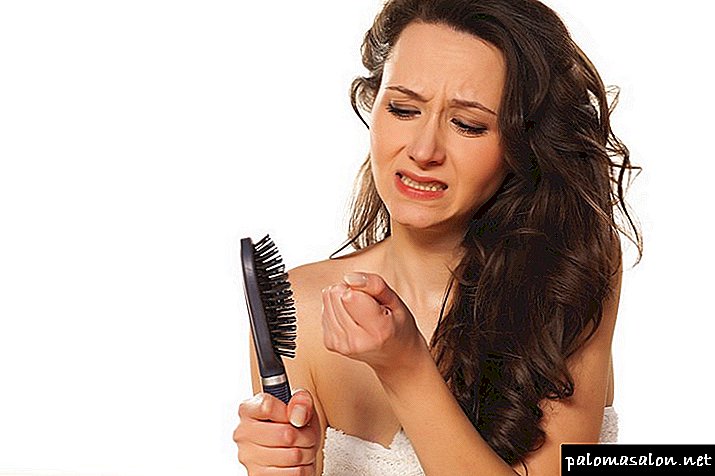
Among the drugs that cause hair loss include:
- doxorubicin
- Taxol
- Taxotere,
- epirubicin.
As a result, the nutrition of the bulbs deteriorates, and this also adversely affects the condition of the hairstyle. Thus, drugs that do not have a direct toxic effect on the follicles can also lead to hair loss. In addition, the stresses associated with the disease and treatment are also complicated, which also adversely affect the state of the hairstyle.
How does baldness occur during chemotherapy?
The most noticeable to others is the loss of hair on the head. But alopecia with chemotherapy affects the whole body - groin, armpits, arms, legs, back and chest. The timing of the onset of baldness in each case is individual, usually the process of hair loss becomes noticeable 3-4 weeks after the start of treatment.
Alopecia is the only side effect of chemotherapy that does not pose a danger to a person’s life or health.
In this case, he passes on his own - after the completion of treatment. hair grow back again.
It is important for each patient to understand that baldness is only a temporary difficulty and know that when he recovers from active life after cancer cures, the state of his hairstyle will get better and better every month.

Chemotherapy Hair Care
You can avoid hair loss during chemotherapy or significantly slow down this process. To do this, you need to carefully care for them and use special physiotherapy.
Physical therapy aimed at preventing hair loss during treatment with anticancer drugs involves cooling the scalp (hypothermia). During this procedure, the vessels narrow, resulting in only a small amount of the toxic drug reaching the follicle.
To cool the skin using special devices like hair dryers that are put on the head. They are used after a chemotherapy session. Since hypothermia, which causes vasoconstriction, does not stop the blood flow in the skin completely, and part of the drug still reaches the hair follicles, this procedure cannot completely prevent its toxic effects. But it significantly slows down the process of hair loss, and this may be enough to save them.
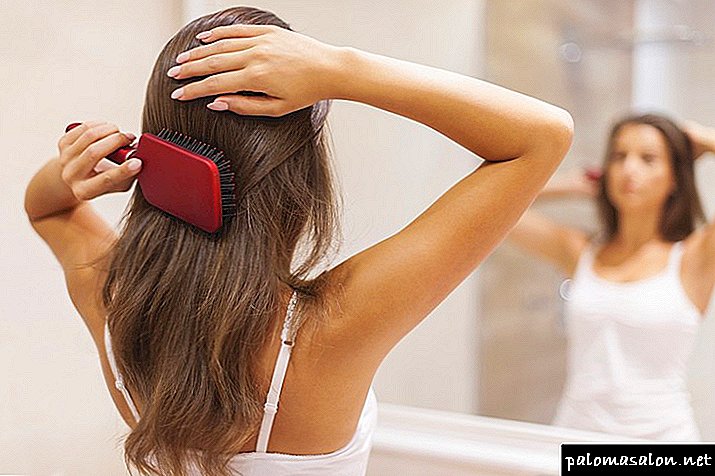
It is also necessary to observe simple hair care rules:
- wash your hair less often using mild nourishing shampoos,
- after each chemotherapy session, let your hair rest by refraining from washing them - the more time passes between taking the drugs and going to the shower, the better,
- use soft combs,
- Do not use a hair dryer and iron to align the hair.
Also a short haircut helps prevent baldness. The shorter the hair, the less food they need, and the easier it is for the bulbs to provide them with sufficient nutrients.
Hair loss during chemotherapy is one of the tests that patients undergo. This process can cause severe psychological experiences, cause the patient a sense of insecurity. But baldness does not always occur. In addition, this is a temporary phenomenon - after a successful cure for cancer hair grow back again.
When does baldness begin?
 Alopecia may begin immediately after the first chemotherapeutic procedure, or it may occur in the third week.
Alopecia may begin immediately after the first chemotherapeutic procedure, or it may occur in the third week.
There are also such drugs, with the use of which baldness does not occur at all.
Many chemotherapeutic agents of the last generation do not cause such problems, after their use the hair coat, if it falls out, then only partially, which remains invisible to others.
Usually, the hair is safely preserved when using targeted therapy. These drugs affect the organic structure selectively, without affecting the hair follicles.
Also, alopecia is absent in the treatment of bone metastases, hormone therapy and the use of drugs like Denosumab or besfosfanatov.
Although for women hair loss is considered a real tragedy, after chemotherapy it is normal. In general, the hair may fall out immediately, but in most cases it occurs in 2-3 weeks.
What if the chemistry began to fall?
Doctors recommend that patients already at the first signs of hair loss shortly cut hair. This will help to avoid such an unpleasant picture, as shreds of hair in the hands after the next chemotherapy session. In addition, after the end of treatment, the hair will begin to grow thick and evenly.
It is completely wrong to persuade or demand from the doctor that he prescribed chemotherapy with drugs that are less aggressive with regard to hair. This is absolutely impossible to do.
Hair then grow back, and thicker and healthier than before. But the use of benign antitumor drugs may not give the desired therapeutic effect, and joking with tumors is a dangerous business.
Some clinics have a drop prevention service. Its essence is that during the chemotherapy the patient is dressed like a helmet with a layer of cooling gel.
The blood supply of the hair follicles during cooling is reduced, which minimizes the negative effects of drugs. Chemotherapy kills less hair cells, so the rate of loss decreases.
There are special drugs to prevent this problem. For example, the drug Minoxidil. This tool was originally created as an antihypertensive drug, but in the course of the tests, its other positive effect was also revealed.
The drug is rubbed into the skin on the head. But it has a lot of adverse reactions, and it is quite expensive.
Will new ones grow?
New hair grows always, although in a single number of patients there was irreversible alopecia. It was connected with too long chemotherapy. In other cases, hair growth over time resumed with a new force.
In some patients, already in the course of treatment, new fluff hairs begin to grow, which eventually develop into thick hair.
Toxins from drugs inhibit hair follicles, but when the introduction of anticancer drugs is stopped, they are gradually restored. Accordingly, the hair also begins to grow.
Therefore, do not particularly worry about this. In all you need to look for positives, because there are pleasant moments in hair loss, especially for women, because the hair will initially fall out not only on the head, but also in the groin, pubic hair, legs and armpits, which temporarily solves the problem of unwanted vegetation on tele.
How long does it take to grow a new hairline?
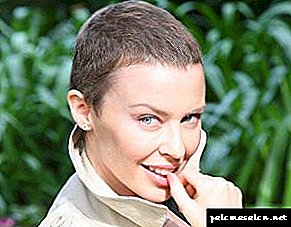 The skin and scalp are always the first to respond to organic detoxification. When will the toxic effect, the hair will begin to grow with the same intensity.
The skin and scalp are always the first to respond to organic detoxification. When will the toxic effect, the hair will begin to grow with the same intensity.
Although in practice, women note that after such treatment, their newly grown hair has become much thicker.
Hair growth on the head after chemotherapeutic treatment usually begins from the moment when all toxic substances trapped in the tissues during chemotherapy, as well as the products of tumor decay, are finally released from the body.
Usually, it will take about six months or a year to fully restore hair.
In addition, many women instead of the usual straight and hard hair began to grow soft curls. Therefore, hair loss due to chemotherapy is a temporary and reversible reaction. You just have to wait.
How to restore hair after chemotherapy?
In order to speed up the restoration of hair, it is necessary to start properly caring for the scalp during chemotherapy treatment.
It is necessary to wash your hair with warm, not hot water, and baby shampoo. Hair dryers, curling irons, curling tongs and irons should be abandoned, because the hair structure is already weakened, and these devices will only strengthen the damage. but not tight gum, otherwise the damaging factor increases, It is better to comb the curls with a massage or comb with rare teeth, and the actions should be neat and careful, refuse to apply braids, it is better to collect hair in a slightly delayed tail get a haircut, Pick up hair cosmetics exclusively with natural ingredients that strengthen and nourish the hair structure. Refrain from using satin or silk material so as not to expose your hair to a static charge.
Be sure to talk with the oncologist, what drugs you can take. Sorbents and vitamin complexes are recommended for hair restoration.
After the chemotherapeutic course, the body is well cleaned from toxins of the membrane plasma exchange procedure. A total of 2-3 procedures are done with a 5-6-day interval, after which the nails and hair begin to grow.
Also the restoration of hair will contribute to such activities:
- You can accelerate the beginning of hair growth with the help of a head massage, which can be done only with complete baldness, otherwise there is a risk of loss of the remaining hair. The head is massaged from the forehead area to the temporal area and the back of the head. Strongly press on the skin is not necessary, light pinkness is enough. An additional positive effect will mask with oils. Using oils like burdock, nettle, grape, sea buckthorn or olive, you can achieve additional nutrition of the scalp with vitamins. To enhance the effect, it is recommended to combine them with ylang-ylang, jasmine or rose oil.
Can I make up?
 Dyeing hair after chemotherapy is not recommended.
Dyeing hair after chemotherapy is not recommended.
The hair and so suffered from the toxic effects of drugs, and then the aggressive effect of paint adds a negative effect.
If there is an urgent need for painting, it is recommended to use only natural paints (without chemical components).Yes, they will hold not so long, but the curls will not suffer so much.
If the staining will be carried out by the salon master, then he must be informed that you are undergoing treatment so that he does not use aggressive methods in his work.
As practice shows, in most cases, it is not possible to avoid alopecia after chemotherapy. Therefore, patients, especially women, are encouraged to mentally and mentally tune in to hair loss, and it is better to have a short haircut before chemotherapy.
Hair must grow, you just need to wait. Such an aggressive treatment has more serious adverse reactions, and hair is only the lesser of the evils. The main thing is to defeat cancer, and to achieve this goal all means are good.



